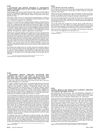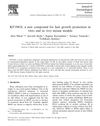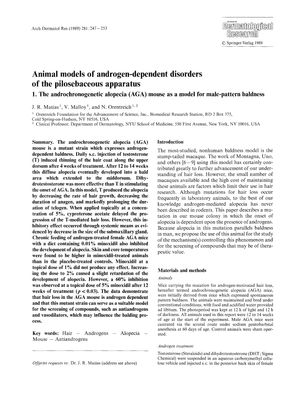TLDR Testosterone causes hair loss in AGA mice, which are good for testing baldness treatments, and both minoxidil and cyproterone acetate can prevent this hair loss.
In 1989, researchers studied the AGA mouse as a model for male-pattern baldness, finding that testosterone (T) injections caused hair loss by affecting the hair growth cycle, with dihydrotestosterone (DHT) being more potent. Topical cyproterone acetate at 5% concentration and a diet with 0.01% minoxidil were effective in delaying or inhibiting T-induced hair loss in these mice. The study demonstrated that the AGA mouse is a suitable model for testing potential baldness treatments due to its similarity to human AGA, with topical minoxidil at 5% showing a 60% inhibition of hair loss after 12 weeks (p < 0.03). The study also noted that the incidence of spontaneous alopecia in AGA mice is low without T treatment, that alopecia severity is age-dependent, and that other hypertrichosis-inducing drugs like diazoxide can inhibit T-induced hair loss, while some others are ineffective.
 25 citations
,
May 1986 in “The American Journal of the Medical Sciences”
25 citations
,
May 1986 in “The American Journal of the Medical Sciences” Minoxidil helps hair growth and boosts self-esteem in balding men.
 18 citations
,
April 1986 in “International Journal of Cosmetic Science”
18 citations
,
April 1986 in “International Journal of Cosmetic Science” Minoxidil promotes hair regrowth in early baldness stages and prevents baldness in non-bald scalps.
 26 citations
,
March 1985 in “International Journal of Dermatology”
26 citations
,
March 1985 in “International Journal of Dermatology” Minoxidil helps hair growth, but results vary.
 24 citations
,
May 1982 in “Biochemical Pharmacology”
24 citations
,
May 1982 in “Biochemical Pharmacology” These drugs cause hair growth without affecting testosterone or adrenal hormones.
 95 citations
,
December 1980 in “The New England Journal of Medicine”
95 citations
,
December 1980 in “The New England Journal of Medicine” Minoxidil helped bald patient regrow hair.
January 2022 in “Wiadomości lekarskie (Warsaw Poland)” MSM reduces hair loss and promotes hair growth in male mice.
The herbal extract CS-10-H significantly promotes hair growth in mice.
January 2009 in “Gynäkologische Endokrinologie” Minoxidil solution can effectively treat hair thinning in women.
 56 citations
,
April 2007 in “Journal der Deutschen Dermatologischen Gesellschaft”
56 citations
,
April 2007 in “Journal der Deutschen Dermatologischen Gesellschaft” Minoxidil works better for female hair loss than alfatradiol, both safe.
 March 2005 in “Journal of The American Academy of Dermatology”
March 2005 in “Journal of The American Academy of Dermatology” Two cosmetic lotions improved hair growth and had better cosmetic effects than 2% minoxidil.
 15 citations
,
April 2001 in “Journal of Dermatological Science”
15 citations
,
April 2001 in “Journal of Dermatological Science” KF19418 promotes hair growth similarly to minoxidil but is not better in live mice.
1 citations
,
January 1991 in “Journal of Dermatological Treatment” Minoxidil doesn't change scalp oil production.
12 citations
,
May 1988 in “Journal of the American Academy of Dermatology” Both 2% minoxidil gel and solution effectively increase hair growth in men with early baldness.
 57 citations
,
July 1987 in “Journal of The American Academy of Dermatology”
57 citations
,
July 1987 in “Journal of The American Academy of Dermatology” Stopping minoxidil treatment resumes balding; continuous use needed for results.









